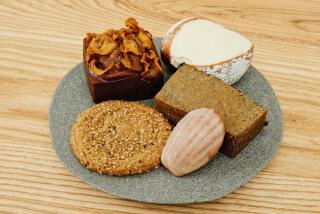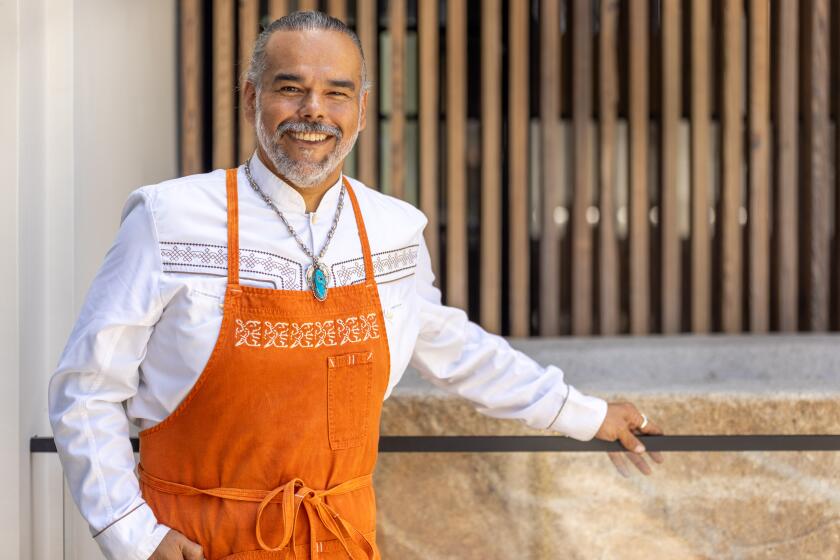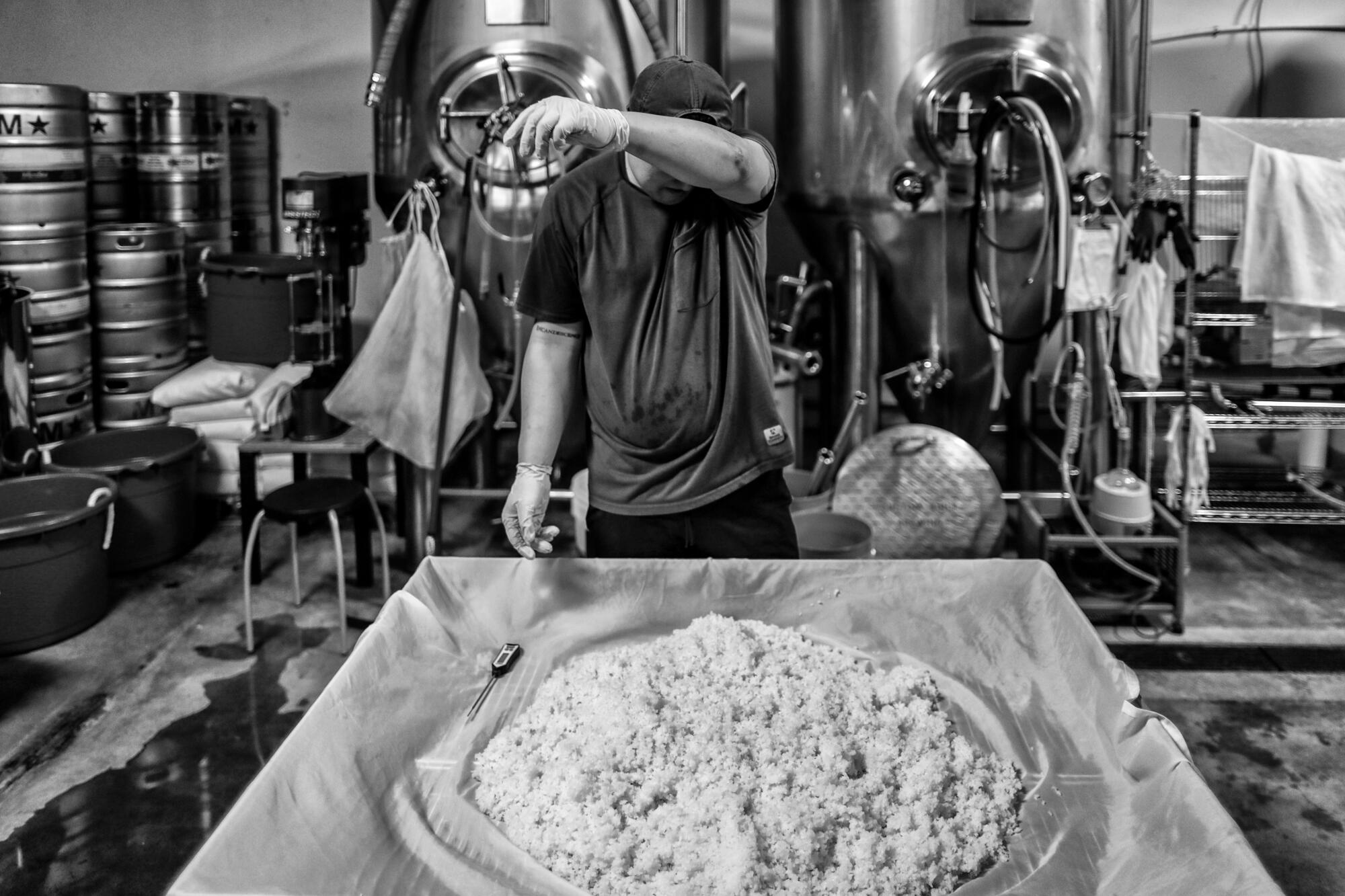
Amid the buzz of fluorescent lights, the intermittent chug of a refrigerator condenser and the flapping hiss of an industrial-size gas flame, Mick Jagger’s voice rises and falls:
Rip this joint, going to save your soul
Round and round and round we go
Roll this joint, going to get down low
Start my starter, going to stop the show
“Exile on Main Street” is blasting from a small stereo that’s tucked under cleaning supplies and stainless steel tools in an industrial park in Covina, Calif. The Rolling Stones are in full effect on this summer evening, and so is 36-year-old sake brewer James Jin. He moves with great purpose — it’s almost a dance — as he takes care of business at Nova Brewing Co., the only craft sake brewery and tasting room in the Los Angeles area.
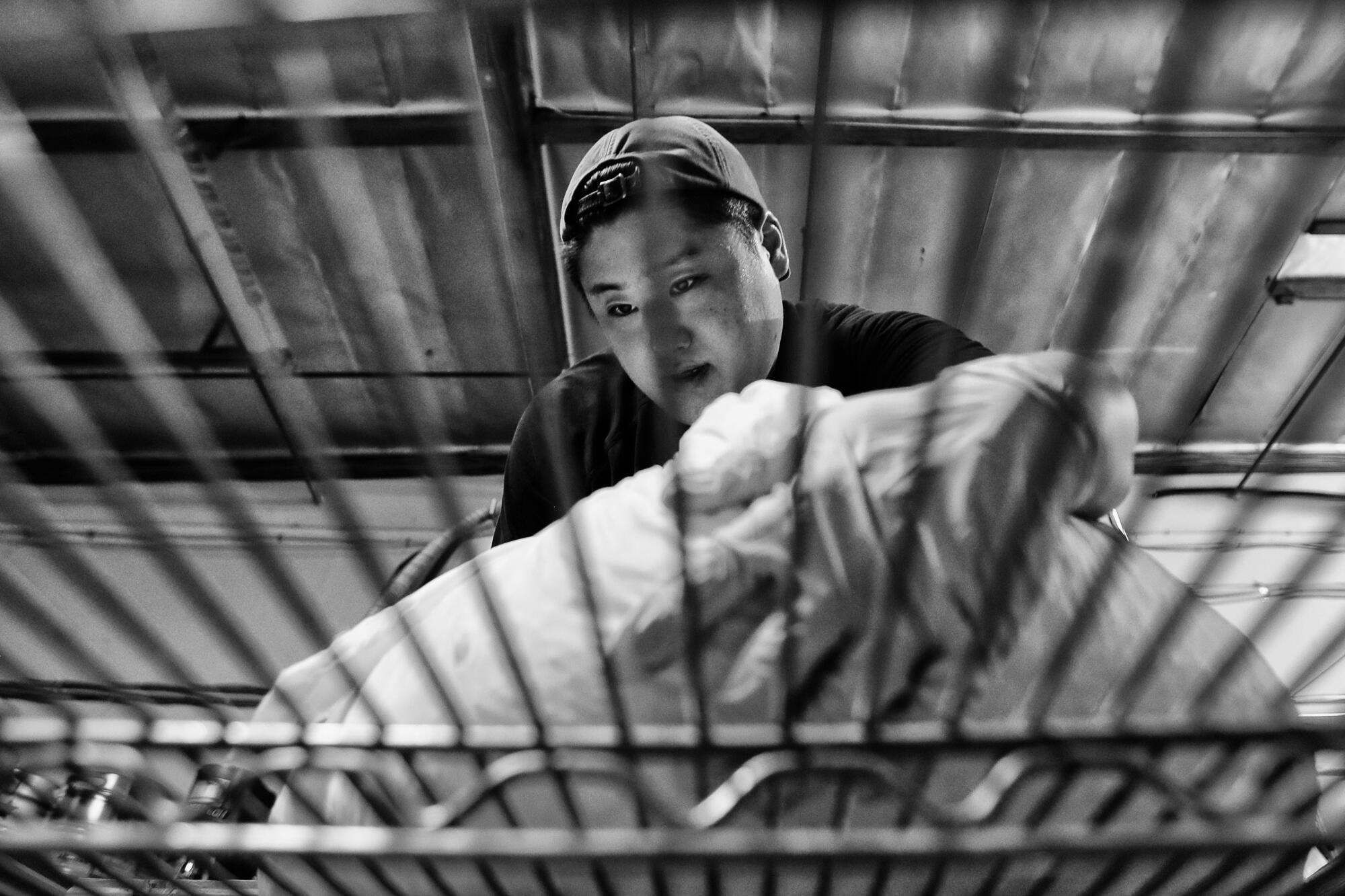
Steaming piles of sake rice cool on a steel rack as Jin feverishly sprays disinfectant on tools and containers. Rice is one of three primary ingredients (in addition to water and koji, a fungus that aids in fermentation) in the alcoholic beverage, and its preparation requires a great deal of attention to things like temperature, humidity and water content.
There’s science and data involved, but Jin seems to approach the brewing more as an art, smashing a few steaming grains of rice between his gloved fingers to see its “heart.” Satisfied, he sprays his gloves with more disinfectant and moves on to the next step.
“When I start brewing,” he said, “there’s so many things going through my head, I go crazy sometimes.”
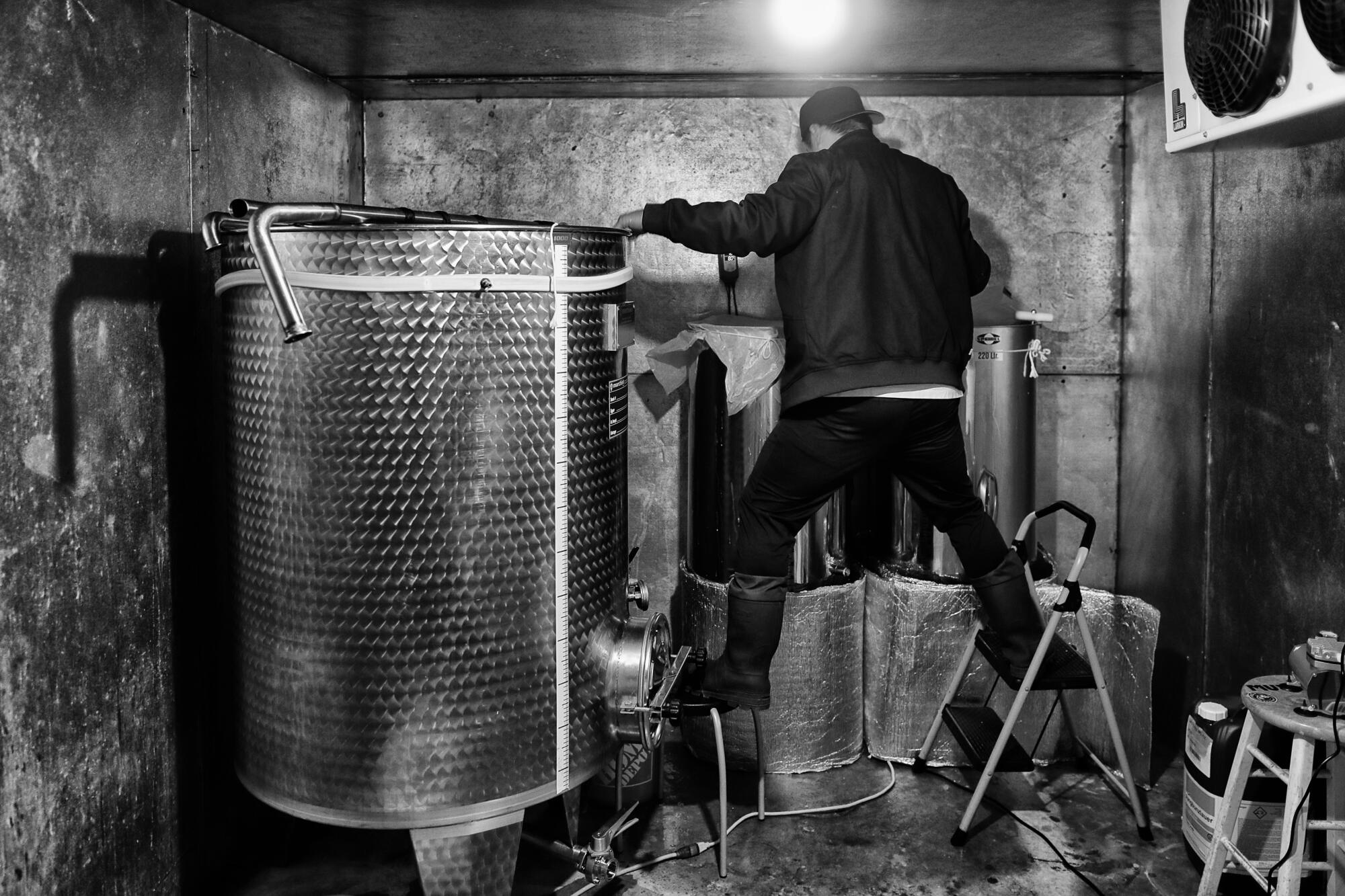
I need a love to keep me happy
I need a love to keep me happy
Baby, baby, keep me happy
Baby, baby, keep me happy
“There’s so many things I have to remember,” Jin says, as he continues to listen to the Stones. “There’s so many things I have to be careful about. I consider it a form of meditation. Especially in the middle of the night. I feel like everybody else is sleeping and I’m all alone. This music is flowing in my head. I feel like I’m dancing inside. It makes me happy.”
//
Jin’s path to Nova Brewing wasn’t exactly a straight line. A native Angeleno, he majored in Japanese at UCLA, finishing his degree in Japan. Then he worked for six months teaching English there and saved enough money to hike throughout Europe and Asia, 26 countries by his count, for nearly two years.
China to Russia, Russia to Ukraine, Ukraine to Poland, Poland to Germany to the Netherlands, to the U.K. England to France, France to Spain, Spain to Italy, Italy to Greece. He traveled by bicycle, train, bus or ferry, staying in youth hostels and eating mostly cabbage and rice to save money. At one point, Jin flew to India, where he studied meditation for a few months and then traveled all around Southeast Asia. At 25, he settled in Thailand. “When I arrived in Thailand, I fell in love with the country, so I got a job and lived there for about four years.”
While teaching English again — to “pay the bills” — Jin says he succumbed to depression, often drinking himself to sleep. “I would be in the countryside teaching, and every night I would be so depressed with nothing to do. I would drink whole bottles of whiskey and, on top of that, four large bottles of beer every day until I passed out. I was drunk at work. I was drunk all the time.”
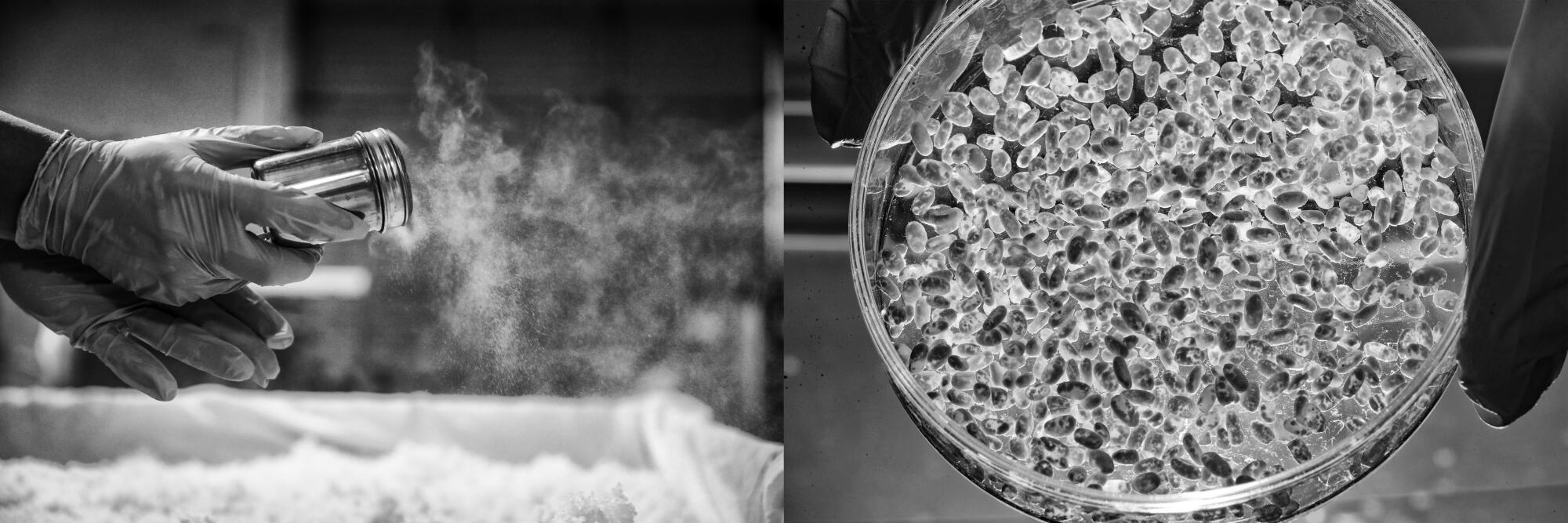
The weight of his own expectations was almost unbearable. “Not knowing what to do with my life. Feeling like I’m making absolutely no change or impact on the world. … Feeling like my life has been wasted,” he recalls. “These thoughts were always in my head since [the] first year of college.”
Eventually, Jin returned home and took a job with Mutual Trading Co., a distributer of Japanese food, alcohol and restaurant supplies. While working as a sales rep at MTC, he became a sake specialist — selling it, organizing educational classes for buyers and restaurant and bar staffs, and organizing sake-related events. His interest became an obsession, and while he was still working at MTC, Jin enrolled in the company’s Sake School of America to become a certified sake sommelier.
And his coat is torn and frayed
It’s seen much better days
Just as long as the guitar plays
Let it steal your heart away
Let it steal your heart away
“I was an alcoholic, previously, so learning about alcohol became a treatment for me,” he says, adding that the Sake School of America “saved my life.”
While he talks, the Rolling Stones continue to play.
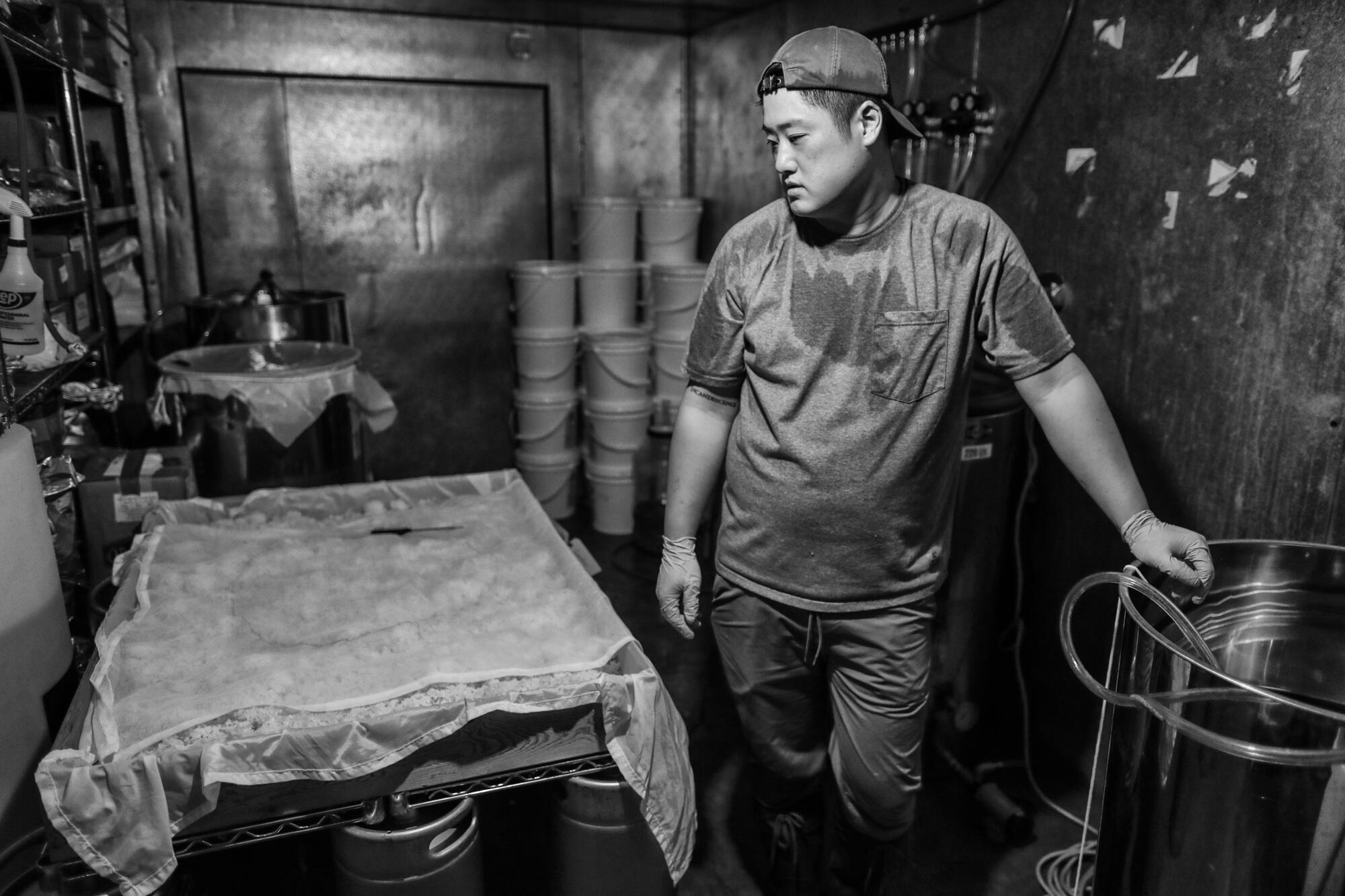
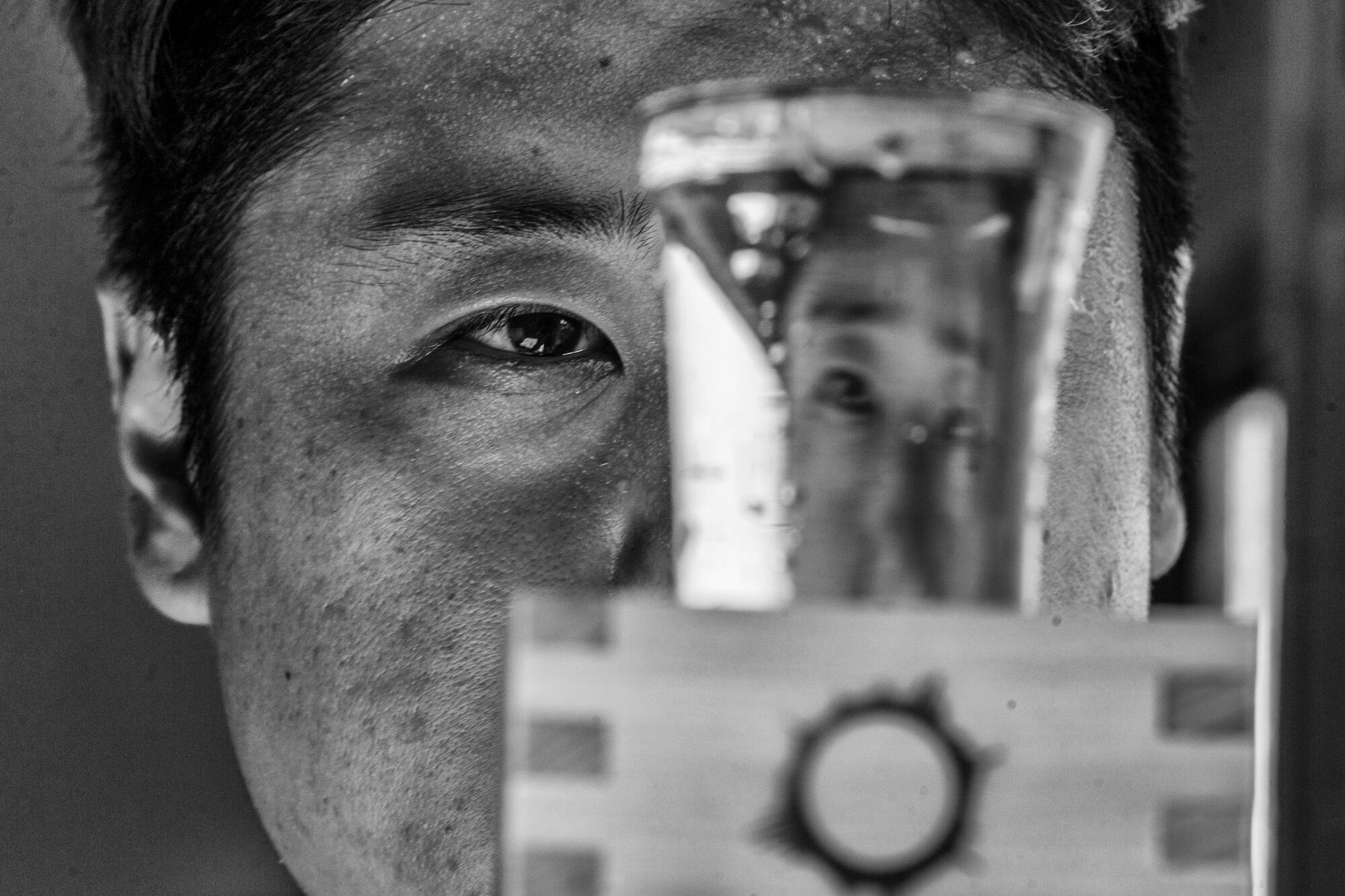
//
Jin met his partner, Emiko Tanabe, a Japanese native who also was studying for a sommelier certificate, at the Sake School of America. They created the social media site Sake Underground in 2018. “We just couldn’t understand why nobody was doing a sake brewery in the L.A. area,” Jin says, so they decided to build their own. He proposed to her in September 2020, and she accepted, sort of. “We both don’t really care for legal marriage so we’re not legally married. We just call each other husband and wife.”
Emiko found the Covina location for the brewery and secured the licenses and permits; James went to Japan for three months to learn traditional methods from master brewer Nobuko Inaba, one of a very few female brewmasters in Japan. They opened Nova Brewing Co. in late December 2019. Jin continued to brew during the pandemic and released his first commercial batch, which he christened Vacuum, in August 2020. (Now Vacuum is available only on tap at the brewery.)
He said he was nervous about moving forward throughout the pandemic but was often reassured by Emiko. Recently, after living for the last few years with his mother at her Diamond Bar home to save money for the business, James, Emiko and their 8-month-old daughter, Yuna, moved into a new home.
//
The origins of sake brewing, dating back centuries, are debated. Many sources trace its beginnings to ancient China. Production in Japan took hold around 500 to 300 BC with the adoption of rice cultivation. Eventually, sake became an important part of Japanese religious and social rituals. The fermenting process evolved from farmers spitting chewed rice into buckets to brewers using complex yeast and koji fungus combinations, promoting fermentation with a range of aromatic profiles.
As Jin continues to work, a steady sweat drips from his forehead. Wearing galoshes and rubber gloves, he is preparing to make his koji rice.
Jin purchases rice that has already been processed in a machine that “polishes” the surface of the grain, or hull, to get rid of protein, fats and lipids, leaving the starchy core. He then washes, soaks and drains the rice before it is steamed.

The brewer uses a secret blend of yellow koji spores (Aspergillus oryzae) and black koji spores mixed with yeast from the Brewing Society of Japan to make the koji rice that creates the distinctive flavor of his sake. That secret blend is used to convert the starch into sugar, which is then fermented into alcohol by the yeast — all in one tank. (The process is known as multiple parallel fermentation and is unique to sake production.)
While doing his best to honor traditional Japanese brewing methods, Jin is determined to create a style unique to Southern California. He uses only Calrose rice grown near Sacramento, imports specialized koji and yeast blends from Japan and has designed and manufactured brewing equipment, frequently using parts purchased at local restaurant supply stores and even Home Depot. In one corner of the shop there’s a small, cylindrical clothes-drying machine he used to rinse his first batches of rice.
“I respect the history of sake brewing, but it’s a dying art in Japan,” Jin says, adding, “Sales of sake [are] constantly going down [there]. I’m one of the few brewers in America trying to bring the dying art back to life.
“We are putting new twists to it. … I respect their history and the culture of brewing, but I took what I learned and I turned it into my own style of modern sake. It’s a lot more appealing to the younger generation. More wine-like, fruitier, higher in acidity, juicy, very fun to pair with food, especially cheese.
“I’m not a Japanese brewer. I’m an American brewer. I purposefully do things they wouldn’t do in Japan.”
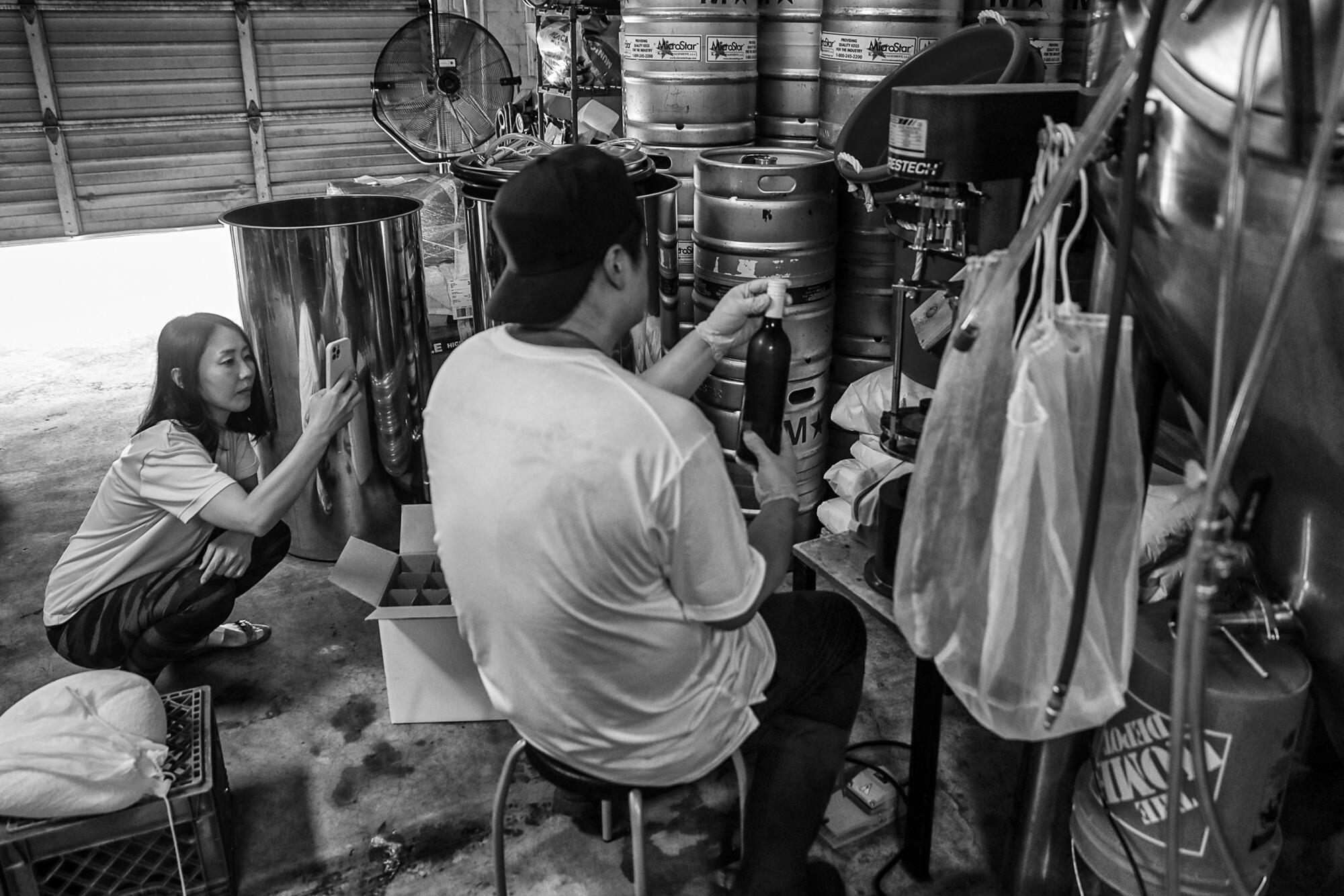
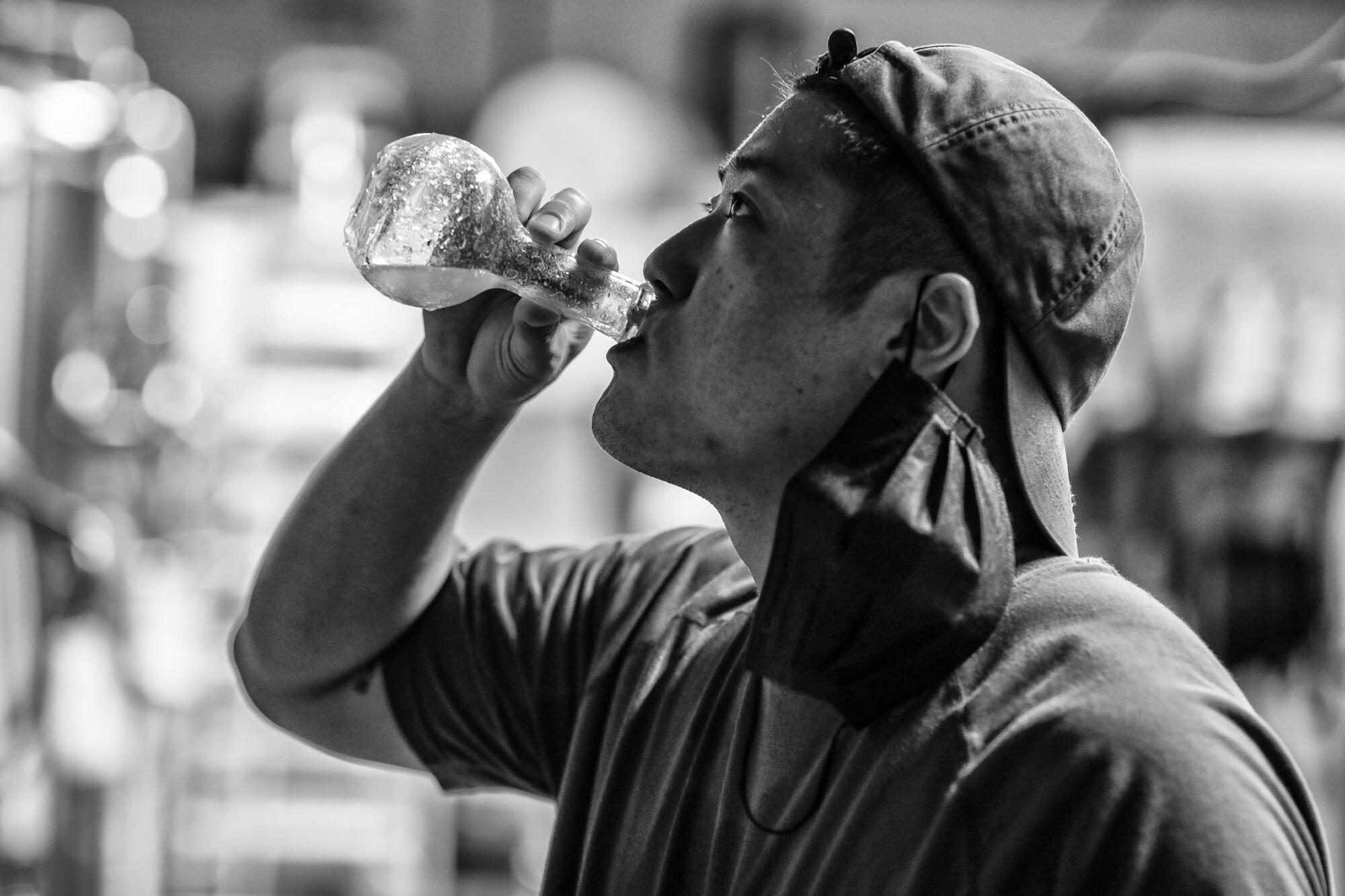
Comments about his first batches were complimentary. Sake Sommelier @Sasaboston on Instagram wrote, “His sake to me is like a juicy melon ball! Finished dry, full and luscious — not like anything I’ve had before.” Master sake sommelier @ueno_toshio wrote, “One of our graduates brought me his sake today, what a treat!!! It is Nama Shizuku Sake … very gentle aroma of banana, yellow apple, ripe pineapple and brioche. Vibrant and juicy mouthfeel with dry refreshing finish.”
Jin says he was just happy his sake “didn’t taste like crap.”
He estimates that in the last 11 months, he’s done 30 batches of sake — equivalent to 5,000 750 ml bottles.
Nova Brewing Co. brews four different sakes, 10 craft beers on tap, and is in the process of producing plum wine. There’s a tasting room connected to the brewery and he accepts appointments for personal tours. “ I want people in L.A. to have the full experience of a local sake brewery,” he says.
//
You’re gonna open up the throttle, yeah
(All down the line)
We’re going to bust another bottle, yeah
(All down the line)
I need a shot of salvation, baby, once in a while
Hear the whistle blowing, hear it for a thousand miles
It’s near midnight and a long day is coming to a close. Jin checks numerous thermometers throughout the space and looks once more at his computer charts. “Exile on Main Street” has been playing on a loop for hours but he doesn’t notice until he switches off the boombox. It’s time to go home.
“My enlightenment is seeing everything done at the end of the day and drinking a glass of Chimay beer. I had a 16-hour day. It was a good day. Everything went smoothly,” he says. “I never would’ve imagined a couple years ago I would be able to make this. Now I’m making it and people are saying they like it. It’s an amazing feeling.”
Next up on the playlist when he returns to work?
Vampire Weekend.
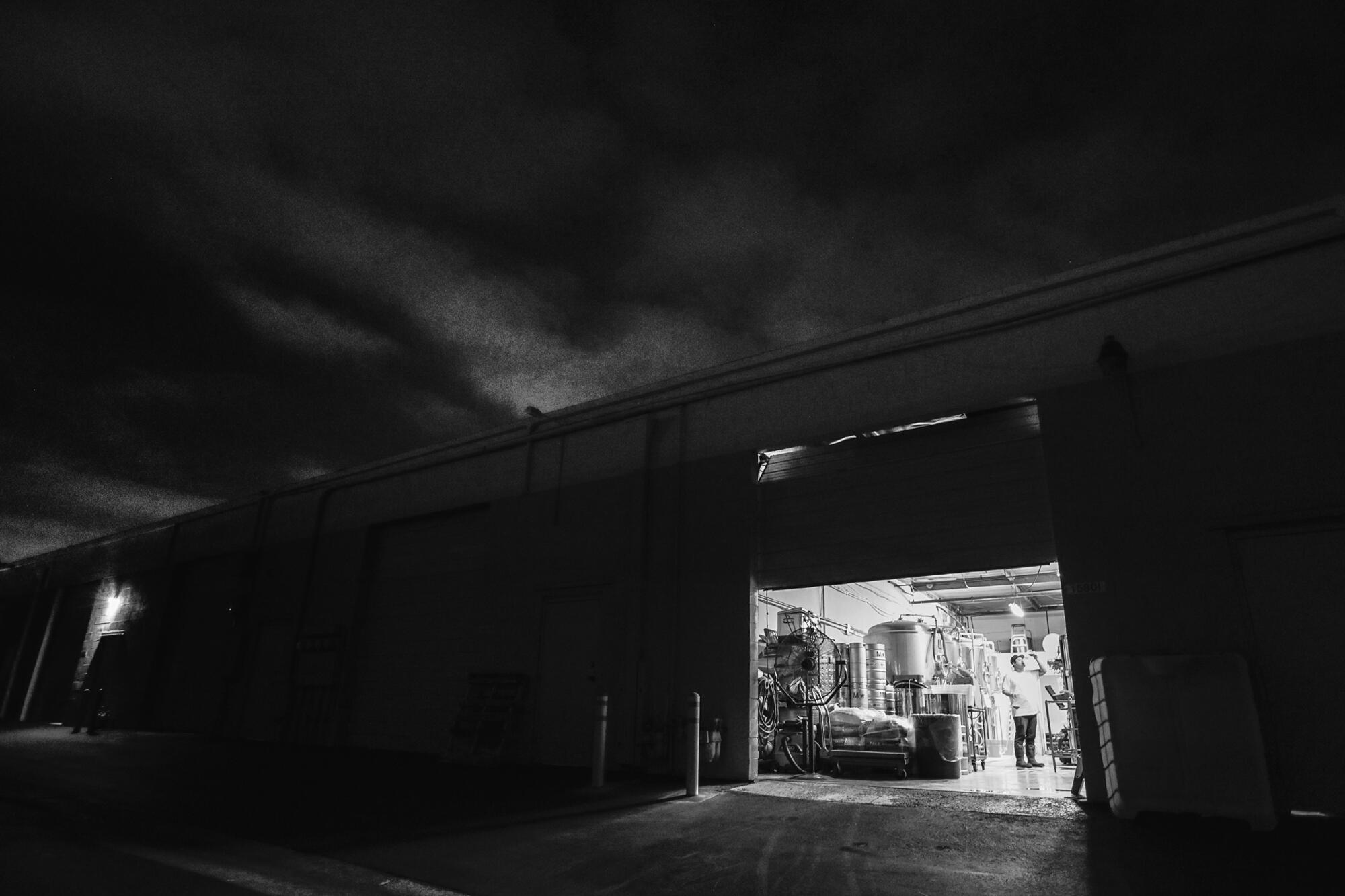
Photo editing by Jacob Moscovitch, Kate Kuo and Taylor Arthur.
More to Read
Eat your way across L.A.
Get our weekly Tasting Notes newsletter for reviews, news and more.
You may occasionally receive promotional content from the Los Angeles Times.
